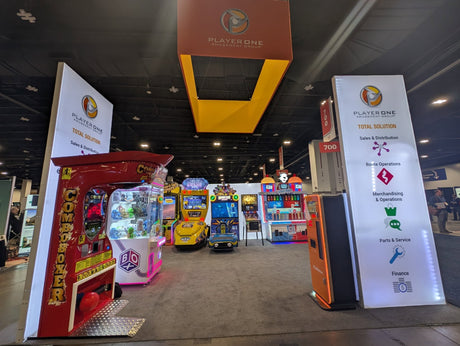Quand un jeu cesse-t-il d'être « juste un jeu » ? Est-ce lorsque les joueurs transpirent en plein milieu d'une partie, ou lorsqu'un groupe d'adolescents se rassemble pour filmer une compétition de danse pour TikTok ?
La frontière entre les jeux d'arcade traditionnels et les attractions à plus grande échelle est plus floue que jamais, et ce n'est pas une mauvaise chose. En fait, comprendre et adopter cette évolution est essentiel pour gérer une salle d'arcade ou un centre de divertissement familial (CDF) moderne et rentable.
Que vous travailliez avec 2 000 pieds carrés ou 25 000, la façon dont vous équilibrez les attractions, les jeux et tout ce qui se trouve entre les deux a un impact direct sur l'engagement des clients, les revenus et le flux opérationnel.
Décomposons-le.
La configuration classique d'une salle d'arcade : jeux ou attractions
Traditionnellement, nous avons classé les offres d'arcade en deux camps :
Jeux d'arcade
- Sessions de jeu rapides (30 secondes à 3 minutes)
- Basé sur les compétences, la chance ou le timing
- Types courants : rédemption, grue, course, sports, flipper
- Idéal pour le jeu spontané et les visites répétées
- Prix de jeu : faible à moyen-faible
Attractions
- Expériences immersives de grande envergure (prévoyez 5 à 15 minutes)
- Adapté aux groupes et à fort impact
- Types courants : bowling, laser tag, arènes de réalité virtuelle, autos tamponneuses, structures gonflables
- Souvent la pièce maîtresse des fêtes et des événements
- Prix de jeu : moyen-élevé
Considérez les jeux comme des en-cas et des petites assiettes : faciles à consommer, addictifs et faciles à reproduire. Les attractions ? Ce sont vos plats principaux : des expériences inoubliables autour desquelles les clients planifient leur visite.
Entrez dans l'hybride : Game-Tractions
Ces dernières années, nous avons assisté à une forte croissance des jeux d'arcade qui se comportent davantage comme des attractions. Il s'agit d'expériences à fort impact, physiquement engageantes et souvent sociales, sans nécessiter de personnel supplémentaire, de dérogations ou de complexité opérationnelle.
Nous les appelons Game-Tractions : des titres d'arcade qui offrent une valeur d'attraction dans une empreinte d'arcade traditionnelle.
Parlons des jeux de danse
Des jeux comme StepManiaX ne sont pas seulement amusants, ils sont un véritable spectacle. Ils transforment les joueurs en artistes et les spectateurs en fans. Ces jeux :
- Stimuler l'énergie sociale (les foules se rassemblent naturellement)
- Attirez des joueurs réguliers et des communautés fidèles
- S'intégrer dans la programmation et les événements compétitifs
- Un attrait pour toutes les générations, des danseurs de la génération Z aux nostalgiques de la génération Y
- Prix de jeu : Faible-Moyen à Moyen
Dans plusieurs de nos sites partenaires, les jeux de danse se classent systématiquement parmi les générateurs de revenus les plus élevés, en particulier lorsqu'ils sont placés dans des zones à haute visibilité.
Et au-delà des chiffres ? Ils créent des moments , ces sensations fortes qui perdurent bien après le générique.
Autres exemples de tractions de jeu
Autres exemples notables qui brouillent les pistes :
- Pilotes immersifs (comme les enceintes de course à siège mobile)
- Bornes VR avec gameplay de type balade sans surveillance
- Jeux de tir à 4 joueurs avec écrans géants et action axée sur l'histoire
- Jeux de collection basés sur des cartes qui prolongent le jeu au-delà de la machine
- Les boxeurs qui attirent les confrontations compétitives
Ces titres offrent généralement :
- Engagement plus long
- Valeur perçue plus élevée
- Interaction sociale élevée
- Conception d'armoire haut de gamme et éléments de mouvement
- Prix de jeu : Bas-Moyen à Moyen-Élevé
Ce ne sont pas « juste un jeu comme les autres ». Ce sont des ancrages visuels qui stimulent le trafic et le partage, en personne comme sur les réseaux sociaux.
Alors, pourquoi les opérateurs devraient-ils s’en soucier ?
Parce que comprendre ces distinctions – et combiner intentionnellement les bons types d’expériences – peut transformer votre entreprise.
Les jeux de danse et les jeux de traction apportent de l'énergie
Ils sont dynamiques, conviviaux et captivants. Placés stratégiquement, ils attirent les clients plus profondément dans votre espace et les incitent à y rester plus longtemps.
Programmation flexible = Meilleur engagement
Vous pouvez organiser des tournois de danse, des défis de classement ou des compétitions chronométrées qui transforment le jeu d'arcade standard en événements récurrents.
Haute valeur, faible complexité
Les jeux de traction vous offrent un attrait de type attraction sans les exigences en matière de personnel, d'entretien et d'espace d'un manège ou d'une arène à part entière.
Partage des revenus favorable
Avec le bon partenaire (comme Player One Amusement Group), vous pouvez accéder à ces titres hautes performances dans le cadre d'accords de partage des revenus , limitant ainsi votre risque en capital tout en maximisant l'impact sur les visiteurs.
La répartition : côte à côte
| Fonctionnalité | Jeux d'arcade | Attractions | Jeu-Tractions |
|---|---|---|---|
| Temps de jeu | Court (30 sec – 3 min) | Plus long (5 à 20 min) | Moyen (3–8 min) |
| Rejouabilité | Haut | Moyen | Haut |
| Appel aux invités | Décontracté, répéter | Axé sur le groupe | Social + Compétitif |
| Complexité opérationnelle | Faible | Haut | Faible-Moyen |
| Besoins en espace | Faible | Haut | Moyen |
| Coût de jeu (relatif) | Faible à faible-moyen | Moyen-élevé | Faible-Moyen à Moyen-Élevé |
Alors, quel est le bon mélange ?
Cela dépend de votre marché, de votre espace et de votre modèle économique. Il n'existe pas de formule parfaite, mais nous recommandons :
- Utiliser les attractions pour générer du trafic piétonnier
- Utiliser les jeux d'arcade pour stimuler la fréquence
- Et utiliser les tractions du jeu pour générer de l'élan et du buzz
Les meilleurs opérateurs analysent régulièrement les données, alternent les jeux tous les trimestres et font preuve de flexibilité. Ce qui fonctionne dans un quartier de divertissement du centre-ville peut échouer dans un centre commercial de banlieue, et inversement.
Il ne s'agit pas seulement d'avoir un excellent équipement, mais de créer une expérience optimale pour votre public.
Vous ne faites pas que concurrencer d'autres salles d'arcade
Vous êtes en concurrence avec tout ce qui prend du temps aux gens : les consoles de salon, TikTok, Netflix et les expériences culinaires.
Qu'est-ce qui est irremplaçable ? La joie de danser aux côtés de son meilleur ami, l'adrénaline d'un combat de boss géant en VR ou les rires partagés d'un nouveau joueur s'affrontant dans un jeu de rythme.
Ce sont des moments qui restent gravés dans la mémoire.
Vous souhaitez créer un mix de jeu performant ?
Chez Player One Amusement Group, nous aidons les centres d'attractions et les salles de jeux d'Amérique du Nord à créer des combinaisons performantes de jeux, d'attractions et de tout le reste. Que vous débutiez ou cherchiez à optimiser votre activité, nos experts sont là pour vous aider.









